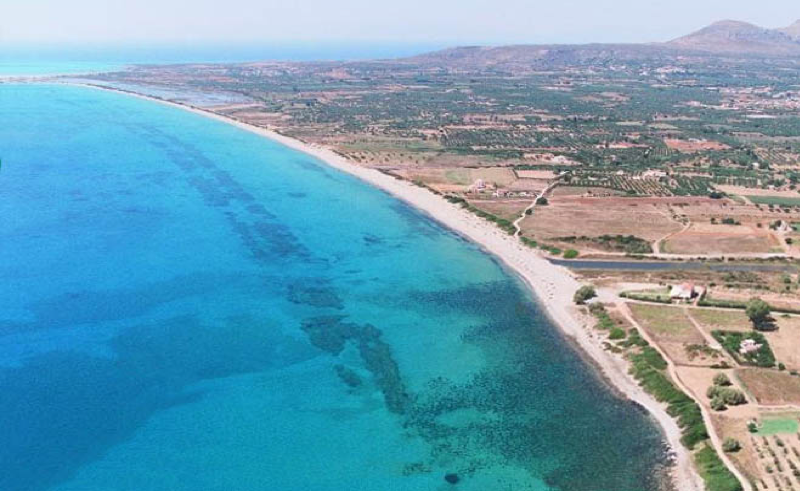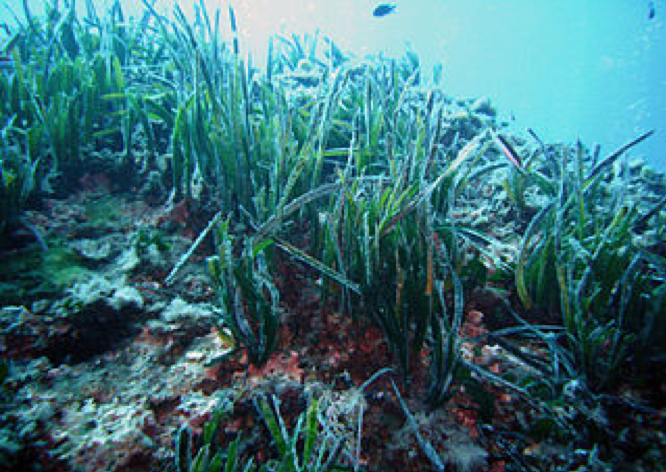
Vatika Bay is a maritime landscape located at the extreme southern end of the Peloponnese peninsula in Laconia Greece. Its marine ecosystem supports numerous endangered and exotic plant and animal species including Posidonia sea grass, Caretta Caretta (loggerhead) sea turtles, Sperm whales and Risso’s dolphins.
Located at an ancient crossroads of Mediterranean navigation, Vatika has long been a hub of seafaring tradition. This heritage lives on in the modern shipping industry, in traditional fishing villages and through art such as the “Sailor of Vatika”, which overlooks the eastern shore at Neapolis (Visit Vatika, 2017).
Vatika is perhaps best known as the site of Pavlopetri, the submerged ruin believed to be among the oldest known underwater sites in the world. Studies conducted during the years 2009-2013 by Dr. Chrysanthi Gallou of the University of Nottingham suggested it dated from the 5thmillennium B.C. The importance of its role in history of Mediterranean seafaring cannot be overstated (Gallou, 2008).
Given this complex environment, it is not unexpected that the interdependence between natural, cultural and historic layers has resulted in conflict due to competing objectives. The issue at hand is that anchor damage from commercial shipping activities is threatening both cultural and natural resources. Locals report that the anchors of large ships scar the bay bottom and destroy the meadows of Posidonia sea-grass there. Posidonia is the basis of Vatika’s ecosystem, providing erosion control, shelter for juvenile marine animals and a food source for multiple species. Because the port is unregulated, a corollary concern is that indiscriminate anchoring will destroy the submerged archaeological site of Pavlopetri.

The issues at Vatika Bay provide valuable insight into strategies in landscape conservation and protection. Furthermore, the escalating response to threats to the cultural and natural resources has been an informative case study in collaboration among local stakeholders and demonstrates the effective application of civil engagement in landscape conservation and protection.
The Harwood Institute for Public Innovation defines civic engagement as an “ongoing process of public conversation that allows people to collect information, share common values, and wrestle together with tough issues where values may be in conflict” (NPS, 2009, p.3). In the case of Vatika Bay public conversations took the form of town hall meetings between and among the surrounding municipalities and resulted in the passage of multiple resolutions calling for resource protections Vatika Bay (Euser 2019). Local attention catapulted the issue to the national and international stages, where representatives of the Greek ministries of both shipping and culture went on record in publicly opposing use of the bay as a commercial anchorage, and even the Assistant Director-General of Culture for UNESCO at the time, Francesco Bandarin, appealed to the Greek authorities for regulatory protection of the site (Euser, 2019; Chhotray 2017).
Unexpectedly, this public outcry resulted in a divergence of strategies in protecting Vatika’s resources. Cultural resource advocates relied upon pragmatic local grass-roots initiatives, whereas environmental strategists pursued a more legal and politically oriented approach.
In 2016 local and international chapters of the Alliance for the Restoration of Cultural Heritage (ARCH) entered the fray and succeeded in nominating the Pavlopetri archaeological site to the World Monuments Fund “watch list” – a list of endangered international cultural heritage sites – and facilitated a “watch day” for stakeholders to come together in solidarity for the cause (World Monuments Fund, 2016). ARCH also kept the issue relevant on social media and began a letter writing program in which shipping companies were engaged directly with respect to their anchoring practices. The correspondence was non-confrontational and aimed at recruiting the industry as a partner in conservation rather than an opponent to it (Bernard, 2018).
Locally, in an agreement between the community and the Greek Euphorate of Underwater Antiquities, marker buoyswere purchased by private contributors and placed around the site to protect it from anchoring. They also succeeded in having the coordinates of Pavlopetri published on the hydrographic charts used by mariners, and discussions with port authorities resulted in the anchorage area recommended by the Coast Guard being located no less than two and one-half nautical miles from the site (Schultz, 2019)

A legal analysis suggested the presence of ships in the bay to be in violation of international laws including MARPOL 73/78 and EU laws including 92/43/EEC (Bernard, 2018). A petition was submitted to the European Parliament protesting the environmental damage inflicted on Vatika Bay and citing evidence from a 2015 Environmental Report published by the Hellenic Center for Marine Research. (European Parliament, 2017). In response, the EU pledged to “draw the attention of the Greek authorities to the need to take adequate measures in order to prevent damage to Posidonia beds from anchoring activities in Vatika Bay” (European Parliament, 2017).
Unfortunately, as of this writing the Vatika Bay landscape is still in jeopardy from an environmental perspective. Despite the legal challenges, Greek authorities recently announced the preparation of a special port regulation which, if passed, will provide a legal means for ships to continue using Vatika Bay as an anchorage. The proposed Natura 2000 designation is yet to be approved, and ships continue to use the bay as an unregulated anchorage and dumping ground.
In conclusion, the collaborative grass-roots efforts of individuals and organizations at Vatika Bay have resulted in enhanced protections for the Pavlopetri submerged archaeological site. These successes exemplify the effective application of civic engagement and highlight the expediency of direct action and locally focused initiatives toward landscape conservation and protection. Conversely the environmental campaigns for Vatika Bay have largely stalled in the purgatory of legislative procedure. Although political will and legislation are necessary for permanent change, this case illustrates the challenges inherent to initiatives based on environmental law and political pressure as they are lost in the muddled maze of national and international bureaucracy.
References
Alliance for the Restoration of Cultural Heritage (2019)Pavlopetri accessed online 3/30/2019 from https://www.archinternational.org/projects/pavlopetri/
Bergin, T. (2015) The Great Greek Shipping Myth: How Greek Shipowners Talk Up Their Role, and Why that Costs Athens Millions, The Greek Crisis, Reuters, accessed online from https://www.reuters.com/investigates/special-report/eurozone-greece-shipping/
Benard, C (2018). Letter from The Alliance for the Restoration of Cultural Heritage to Mattheou Dimitrios, CEO, Arcadia Ship Management dated 11/06/2018
Bing, n.d.Freight, Photographic Image, Pixabay. from https://www.bing.com/images/search?view=detailV2&id=15EF8BE5010FEE1C2F8D7B4E6E35FEF552BAE11E&thid=OIP.LW6R5jQjM-cpY3mjCHZHOwHaFj&mediaurl=https%3A%2F%2Fcdn.pixabay.com%2Fphoto%2F2015%2F07%2F27%2F20%2F22%2Ffreight-863449_960_720.jpg&exph=720&expw=960&q=Creative+Commons+commercial+shipping+photos+&selectedindex=207&ajaxhist=0&vt=0&eim=1,2,6
Bing, n.d. Gres-Pavlopetri, photgraphic image, Wikimedia, accessed online from https://upload.wikimedia.org/wikipedia/commons/1/1a/Gres-Pavlopetri.jpg
Bing, n.d., Posidonia Oceanica Portofino 01, photographic image, Wikimedia, accessed online from https://upload.wikimedia.org/wikipedia/commons/thumb/a/ab/Posidonia_oceanica_Portofino_01.jpg/320px-Posidonia_oceanica_Portofino_01.jpg
Chhotry S. (2017) Vatika Bay Hope Spot: Ancient Grecian City Abuts Marine Abundance , National Geographic, accessed online 03/31/2019 at https://blog.nationalgeographic.org/2017/04/04/vatika-bay-hope-spot-submerged-ancient-grecian-city-abuts-marine-abundance/
European Parliament (2017), Petition No. 11078/2016, Committee on Petitions, accessed online at http://www.europarl.europa.eu/sides/getDoc.do?type=COMPARL&reference=PE-610.664&format=PDF&language=EN&secondRef=02
Euser, B. (2019) Our Story, Ships Wreck Vatika Bay. Facebook. Accessed online 03/25/2019 at https://www.facebook.com/pg/Ships-Wreck-Vatika-Bay-916797861708584/about/?ref=page_internal
Gallou, C. (2008) ‘Between Scylla And Charybdis’: The Archaeology of Mycenean Vatika on the Malea Peninsula,British Archaeological Reports Series 1889, Archaeopress,Oxford UK, accessed online 3/31/2019 from https://www.academia.edu/1826373/C._Gallou_2008._Between_Scylla_and_Charybdis_Vatika_in_Mycenaean_times_in_Dioskouroi._Studies_Presented_to_W.G._Cavanagh_and_C.B._Mee_for_their_30-year_joint_contribution_to_Aegean_Archaeology_ed._C._Gallou_M._Georgiadis_and_G._Muskett._BAR_IS_1889_pp._292-321._Oxford_Archaeopress
National Park Service (2009) Stronger Together: A Manual on the Principles and Practices of Civic Engagement. US DOI, NPS Conservation Study Institute, Woodstock
National Park Service (2017) National Heritage Areas Website. Feasability Studies. Accessed online 4/2/2019 from https://www.nps.gov/subjects/heritageareas/index.htm
Schultz, S. (2019). Underwater Update, Alliance for the Restoration of Cultural Heritage, accessed online 3/29/2019 from https://www.archinternational.org/2019/03/09/underwater-update/
Visit Vatika (2017) Settlements: Profitis Elias, accessed online 3/30/2019 from https://www.visitvatika.gr/en/vatika/settlements/prophitis-elias.html
World MonumentsFund (2016), Pavlopetri Project, Accessed online from https://www.wmf.org/project/pavlopetri
Guest Observer: James Wright is a graduate student in Cultural Heritage Management at Johns Hopkins University. He has a background in maritime heritage and submerged cultural resources, and has worked on projects with the, the Lighthouse Archaeological Maritime Program in St Augustine Florida, the Florida Public Archaeology Network and the Maritime Archaeological Historical Society in Washington D.C. James currently works with the Alliance for the Restoration of Cultural Heritage on the Pavlopetri project, maintaining a database documenting commercial shipping in Vatika Bay, Lakonia Greece.



One Response
The author wishes to acknowledge and correct his spelling error…
Benard, C. (correct spelling) is the president of ARCH international.